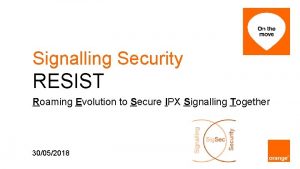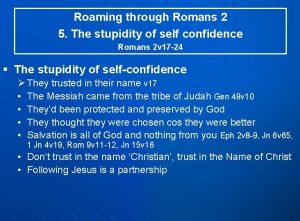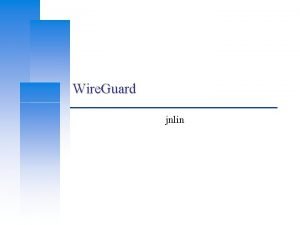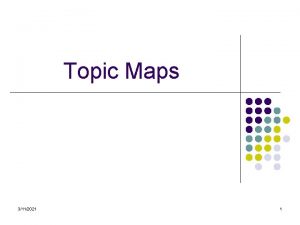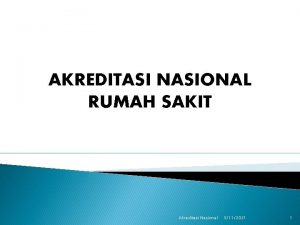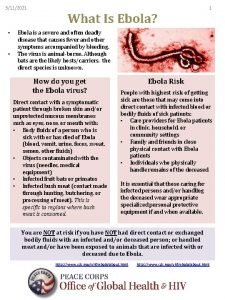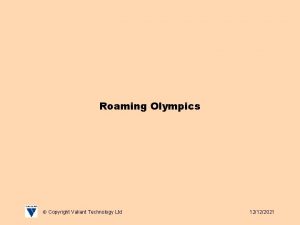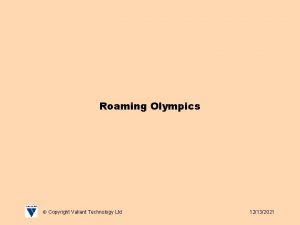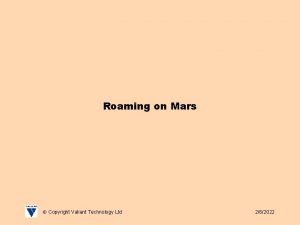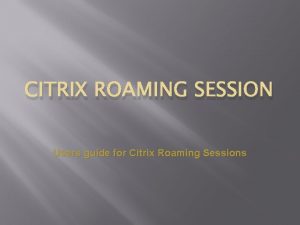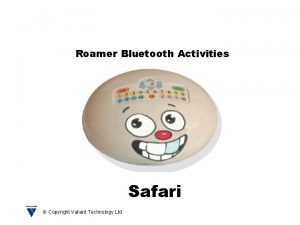Roaming on Mars Copyright Valiant Technology Ltd 3112021















- Slides: 15

Roaming on Mars Copyright Valiant Technology Ltd 3/11/2021

Roaming on Mars This activity was written by Greg Vogt of NASA's education department, Johnson Space Centre, Houston. Context The year is 2003. You are a member of a Mars Robotic Exploration Team. Two weeks ago, the NASA Pathfinder III spacecraft landed on Mars. Telemetry (radio data) from the spacecraft has indicated all systems on board are functioning perfectly. The mission director has approved the first remote investigation, which will commence tomorrow. The goal of this investigation is to look for water ice in the Martian soil. Copyright Valiant Technology Ltd 3/11/2021

Roaming on Mars Context Your team has to prepare a route map for the microrover laboratory which will depart the Pathfinder III, travel to five investigation sites, and return. The sites were determined by the science team to be locations likely to have ice deposits beneath the soil surface. The roving laboratory must visit each site and stop for 30 minutes to permit sampling tools to collect and store soil and ice samples (if present). The roving laboratory will have sufficient energy resources to operate for 5 hours. Copyright Valiant Technology Ltd 3/11/2021

Roaming on Mars Challenge The science team has provided your team with a map showing the location of Pathfinder III on Mars and the five sites to be studied. Also provided are topographic data of the landscape. This information is essential because there are some areas too rough or too steep for the roving vehicle to safely travel through. It is your team's objective to plot a route for the microrover to follow that will permit it to visit each site, conduct its studies, and return to Pathfinder III within the time allowed. Copyright Valiant Technology Ltd 3/11/2021

Roaming on Mars Challenge To confirm the route plan, you will conduct a simulation using the Roamer robot. After plotting your route on the map, you will write a program for the Roamer permitting you to test the route. Then you will program the Roamer and run a sampling mission simulation on a model of the Martian surface. If your Roamer visits each site and returns to Pathfinder III within the time allowed, you will have successfully completed your mission. Copyright Valiant Technology Ltd 3/11/2021

Roaming on Mars Challenge Because you are doing a model study, you will be employing various scales for measurement. The map will have a scale of 1: 10. This means that one centimetre on your map will equal 10 centimetres on the model. The model, however will have its own scale compared to the actual Martian surface. The scale will be 1: 1000. This means that one centimetre on your model will equal 1000 centimetres (10 metres) on Mars. You will also use a 1: 60 scale for time. One second of Roamer operating time on your model will equal one minute of microrover operation on Mars. You are limited to 5 hours of operating time on Mars. Therefore you are permitted only 5 minutes of operating time on your model. Copyright Valiant Technology Ltd 3/11/2021

Roaming on Mars Background Information Mars is a small planet of about 6, 800 kilometres in diameter. The gravity force at the Martian surface is about 38 percent that at Earth's surface. A 70 kilogram person on Earth would weigh only 27 kilograms on Mars rotates on its axis every 24 hours and 37 minutes. Its axis is tilted like Earth's, causing the planet to have seasons. Because Mars is further from the sun that Earth and has a longer orbit, its seasons are almost twice as long as Earth's. The temperature at the surface ranges from a cold 133 degrees Celsius to a high of 27 degrees Celsius. Copyright Valiant Technology Ltd 3/11/2021

Roaming on Mars Background Information The atmosphere of Mars is very thin. The pressure is about the same that exists on Earth at an altitude of 37, 000 meters (about 4 times higher than Mount Everest). Because of the very low pressure, about 125 th that of Earth's atmosphere, liquid water cannot exist on Mars's surface. Previous spacecraft missions have detected ice in the Martian polar caps but none in the equatorial regions. Copyright Valiant Technology Ltd 3/11/2021

Roaming on Mars Background Information One of the important questions about Mars is what happened to Mars's water. The 1971 Mariner 9 mission to Mars photographed small channels on the Mars surface that look very much like water-cut channels on Earth. Later spacecraft also observed the channels. Scientists have speculated that Mars may have had a thicker atmosphere in its distant past. If so, Mars could have had lakes and oceans, rain and snow. Water runoff could easily have cut the channels. However, no spacecraft has discovered any of water ice being present in these locations. One of the objectives of the Pathfinder III mission is to try to find waterice on Mars and analyse any gas that might be frozen inside it. The gas would tell scientists what Mars's atmosphere was once like. Copyright Valiant Technology Ltd 3/11/2021

Microrover Mission Materials 1. Roamer Martian Surface Map Metric Ruler Protractor Pencil Martian Model Print out the map of the area around the landing site. Using pencil, draw a possible route on the map for the Microrover to travel from Pathfinder III to each of the five study sites and return. The landing site has three nearby channels, two craters and three boulder fields. For this investigation, these areas be avoided. Copyright Valiant Technology Ltd 3/11/2021

Microrover Mission 2. Measure the lengths of each trip segment in centimetres. Create a data table to record this information. Because the map scale is 1: 10 , each centimetre you measure on the map represents an actual distance of ten centimetres on the model. For example, if a map segment measures as 9. 6 centimetres, the distance the Roamer must travel is 96 centimetres. Also record on the table the angles the Roamer must rotate in order to get to each site. 3. Total all map segments at the bottom of your table to determine how far the Roamer must travel to complete its mission. Copyright Valiant Technology Ltd 3/11/2021

Microrover Mission 4. Estimate how long it will take for the Roamer to follow the course on the model. Because the microrover on Mars will remain at each of the five study sites for only 30 minutes, the actual travel time from Pathfinder III to the sites and back will only be 2. 5 hours. On your model, you will have only 2. 5 minutes for the Roamer to complete its task. 5. Repeat steps 1 to 4 for a different route. When the second route has been completed, select the best one for your test. How did you determine which route is best? Copyright Valiant Technology Ltd 3/11/2021

Microrover Mission 6. Write a program on the microrover program sheet for the Roamer. The program should direct the Roamer to follow your chosen route on the Martian model. To save simulation time, do not program the Roamer to wait at each sample site for its scientific research to be carried out. These wait times will be added to the program for the microrover on Mars when the program is transmitted. Copyright Valiant Technology Ltd 3/11/2021

Microrover Mission 7. Test your program by running the Roamer on the model. Place the Roamer directly over the site for Pathfinder III and execute the GO command. Use a stopwatch or a watch with a second hand to time how long the Roamer takes to travel the complete route. It is only necessary for the Roamer to cross over a part of each study site before going on to the next location. If the Roamer misses any study site, stop the simulation and analyse your program for errors. Correct your program and try the simulation again. Copyright Valiant Technology Ltd 3/11/2021

Microrover Mission 8. When you have successfully completed your mission, submit your simulation report containing the following information to your teacher: Final Route Map Data Table with distances, angles and estimated times Valiant Roamer program Simulation Results (including the actual time for completion) Copyright Valiant Technology Ltd 3/11/2021

